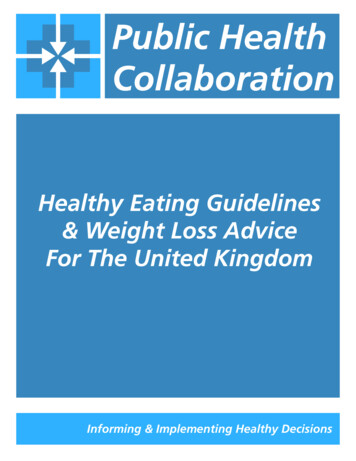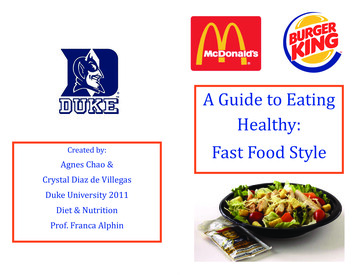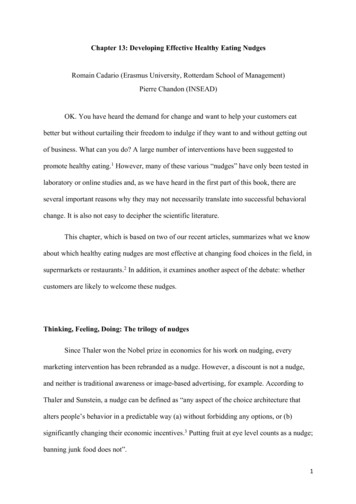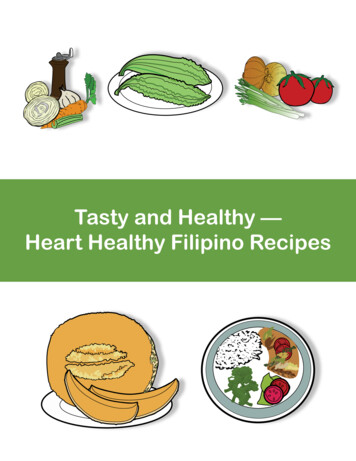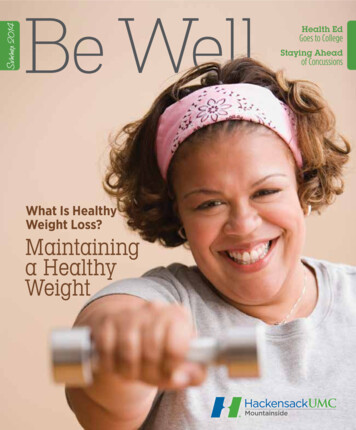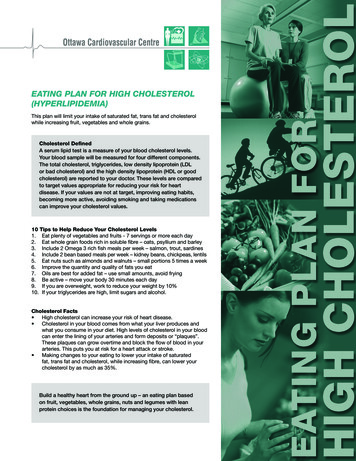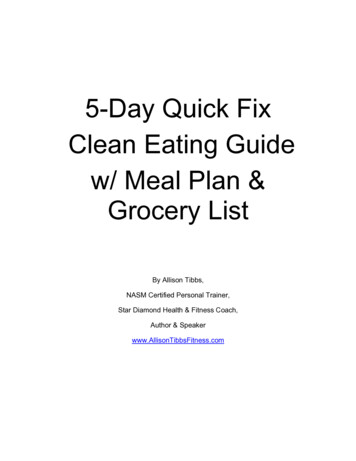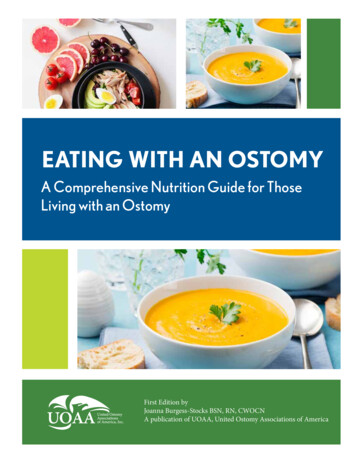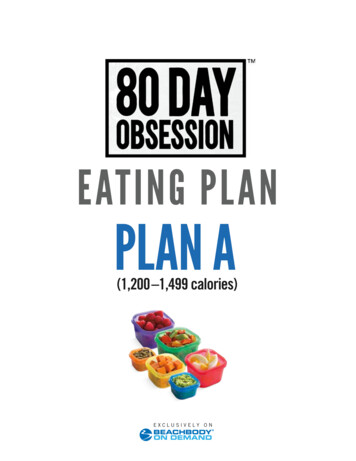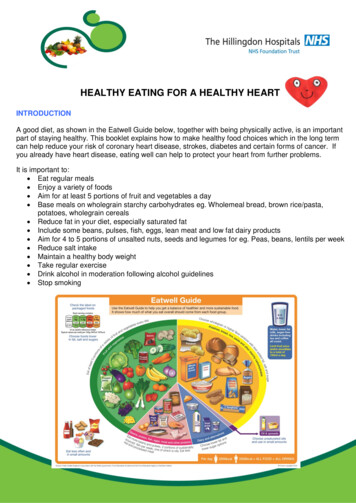
Transcription
HEALTHY EATING FOR A HEALTHY HEARTINTRODUCTIONA good diet, as shown in the Eatwell Guide below, together with being physically active, is an importantpart of staying healthy. This booklet explains how to make healthy food choices which in the long termcan help reduce your risk of coronary heart disease, strokes, diabetes and certain forms of cancer. Ifyou already have heart disease, eating well can help to protect your heart from further problems.It is important to: Eat regular meals Enjoy a variety of foods Aim for at least 5 portions of fruit and vegetables a day Base meals on wholegrain starchy carbohydrates eg. Wholemeal bread, brown rice/pasta,potatoes, wholegrain cereals Reduce fat in your diet, especially saturated fat Include some beans, pulses, fish, eggs, lean meat and low fat dairy products Aim for 4 to 5 portions of unsalted nuts, seeds and legumes for eg. Peas, beans, lentils per week Reduce salt intake Maintain a healthy body weight Take regular exercise Drink alcohol in moderation following alcohol guidelines Stop smoking
CHOLESTEROLCholesterol is a fatty substance carried around thebody by proteins. When cholesterol and proteins arecombined, they are called lipoproteins. There are twotypes of lipoproteins: low-density lipoproteins (LDL)and high-density lipoproteins (HDL).LDL Cholesterol (sometimes called ‘bad’cholesterol):LDL cholesterol travels around your body from theliver to the blood vessels. If levels are too high, LDLmay build up in blood vessels, causing plaque asshown in the picture, causing damage. This can leadto raised blood pressure, clots and heart attack.HDL Cholesterol (sometimes called ‘good’cholesterol):HDL cholesterol travels around the body collectingLDL cholesterol from the lining of the blood vesselsand returning it to the liver, where it is broken down. This type of cholesterol can protect your heart.Our cholesterol levels have been linked to the fat content of our diets.FATSFats in the diet can be divided into two groups as per the table below:Saturated FatUnsaturated fat whichincludes:TypeSaturated Fat including Trans fat a high intake increases levels of LDLcholesterol.Monounsaturated Fat - candecrease LDL and raise HDLcholesterol.Sourcesanimal products, ghee, lard,butter, coconut oil and manyprocessed foods eg. cakes,pastries, biscuits, sausages,hamburgers, ready mealsolive oil, rapeseed oil, olive oilspreads, multigrain bread, nutsand seeds, avocados.Polyunsaturated Fat - candecrease LDL and HDL cholesterolsunflower oil, corn oil, oily fish,some nuts and seedsIt is best to try and reduce total fat intake particularly if you are overweight. Saturated fats can bereplaced with a small amount of unsaturated fats.
Tips for reducing total and saturated fat:1.2.3.4.5.6.7.8.9.Replace butter, ghee, lard with a little oil or spread that is high in monounsaturates such asrapeseed oil or olive oil (check labels, as normal vegetable oil is often rapeseed).Cut visible fat off of meat and remove skin from poultry.Aim for 2 portions of fish per week, 1 of which is oily (eg. Mackerel, kippers, pilchards,salmon, sardines and fresh tuna (not canned))Grill, steam, boil, microwave, bake or poach foods, avoid frying.Reduce your intake of pastry, biscuits, cake, chocolate, crisps.Try using lower fat dairy products or alternatives such as semi-skimmed or skimmed milk.Try low fat yoghurt or ½ fat crème fraiche instead of cream.Try lower fat cheeses for eg. cottage cheese, ½ fat cheddar or ½ fat cream cheeseGrate cheese as it makes it go further. Use mature cheeses but only small amounts eg 25g.FIVE-A-DAYFruit and vegetables are a good source of: Antioxidants, which help prevent damage to blood vessels. Soluble fibre, which help to reduce blood cholesterol levels. Vitamins and MineralsVitamins are easily lost during food storage, preparation and cooking. To maximise the vitamincontent: Steam, microwave or lightly boil in a small amount of water. Raw as snacks.Try to eat a mixture of 5 fruit and vegetables a day. If you eat less than 5, aim to increase themgradually.You can choose from fresh, frozen, dried or canned. Opt for canned fruit in natural juice or cannedvegetables, with no added salt.What is a portion of fruit or vegetables?FruitPortionVery large fruit, eg. melon, pineapple1 sliceLarge fruit, eg grapefruit or mango½ fruitMedium fruit, eg, apple, orange, bananaSmall fruits, eg. plums, satsumas, kiwis,apricots1 fruit2 fruitsVery small fruit, eg. grapes, berries, cherries1 cupful (7-10)Dried fruit, eg. sultanas, dates, raisins1 tablespoonCooked or canned fruit1-3 tablespoons
VegetablesPortionCooked vegetables1-3 tablespoonsMixed salad1 dessert bowlVegetable sticks, eg. carrots, pepperHandfulPulses, eg. beans, lentils, chick peas3 heaped tablespoons(more than this is still only 1portion)Only include 1 small glass (150mls) of fruit or vegetable juice as 1 portion a day.INCLUDE STARCHY FOOD AT EACH MEALStarchy foods provide energy, vitamins and minerals. They are naturally low in fat and can help you tofeel full, particularly the whole grain or wholemeal varieties. They can also be a good source of fibre.FIBREThere are two types of fibre, shown below. Choose from both sources to keep healthy.Soluble fibre- helpful in loweringcholesterol levelsInsoluble fibre – will help to fill you up andis important for digestionFruit and vegetablesOats and foods made with oats (eg. Porridge)PeasBeansPulses eg. lentilsWholegrain breakfast cereals (eg.Weetabix)Wholemeal pitta, bread, chappatisBrown rice and pastaPotatoes, sweet potato and vegetable skinsSeedsMake sure that you drink plenty of fluids each day, particularly when you are increasing your fibreintake. Aim to have 6-8cups (2 litres/4 pints) of fluid a day. Choose from a variety of sources, eg.water, no added sugar squash, diet soft drinks, tea, coffee.LIMIT YOUR INTAKE OF SALTA high salt intake can lead to raised blood pressure, heart disease and stroke. Itis recommended that the average intake of salt is less than 6g 1 teaspoon perday. However, 75% of the salt that we eat is already in the foods we buy.Ways of Reducing Salt Intake: Choose less processed foods (ready meals, soups, bottles sauces, cannedproducts) and eat less salty foods (ham, bacon, smoked fish, cheese,salted butter, yeast extracts, stock cubes). Try not to add salt to cooking, instead use herbs, spices, pepper, lemon juice, garlic, vinegar ormustard for flavouring (check food labels of mixed or blended spices). Try not to add salt to food at the table, and make sure that you always taste food first. Cut down on salty snacks such as crisps, salted nuts and biscuits and olives.
Buy canned vegetables and fish labelled “no added salt” or those tinned in water not brine or oil.Sea salt / rock salt are no different to ordinary salt and therefore the intake of these should also bereduced. Salt substitutes are not recommended. Try to reduce salt intake gradually to allow your tastebuds to adjust.SUGARSugar contains only calories with no other nutrients. Decrease your sugar intake if you are overweightor have increased triglyceride levels.Suggestions for reducing sugar: Avoid adding sugar to food and drinks – try an artificial sweetener instead. Choose no added sugar or low sugar squash or diet fizzy drinks. Cut down on cakes, biscuits, sweets, chocolate, jam, marmalade, syrup, treacle and honey. Choose breakfast cereals with a low sugar content, eg. porridge, Shredded Wheat, Weetabix. Choose reduced sugar puddings, eg. sugar-free jelly, fruit and diet yoghurts. Choose fresh or fruit canned in natural juice instead of syrup. Check food labels for added sugar. Syrup, honey, raw sugar, cane sugar, brown sugar,muscovado and concentrated fruit juice are all types or sugar. Sugar may also be described onfood labels as glucose, sucrose, fructose, dextrose, maltose or corn syrup. Be aware of foods labelled “low fat” – some may be high in sugar – check the nutritioninformation panel (aim for less than 5g sugar per 100g).ALCOHOLRegularly drinking above the recommended intake has been shown to increase blood pressure, whichin turn increases the risk of cardiovascular disease.Current safe drinking recommendations: 14 units a week for both men and womenWhat is a unit of alcohol? ½ pint (300mls) of standardstrength (3-4% alcohol byvolume (ABV)) beer, lager orcider One small glass of wine(125ml) One measure of spirits (25mls) One small glass of sherry orfortified wine (50mls)Alcohol contains calories (1g 7 calories) and can also contribute to weight gain.Important Points Avoid binge drinking, and try to have at least 2 alcohol free days per week.
Variation in alcoholic strength: beers, lagers and ciders contain range from 3% ABV to as muchas 9% ABV. Wines can vary from 8% to as much as 12-14% ABV. Low-alcohol drinks: Some are virtually alcohol-free whilst others are as high as 1.2% ABV.They may also be high in sugar, aiding weight gain. Read the label.If you are on any medications, always consult your doctor before taking alcohol.A GUIDE TO FOOD LABELLINGLook at the label where it says ‘per 100g’ and use the table below as a guide to compare products.A LOTA LITTLEMore than 22.5g of sugars5g or less of sugarsMore than 17.5g of fat (5g ofsaturates)3g or less of fat (1.5g or less ofsaturates)More than 1.5g salt0.3g or less saltEat a little of the foods that contain ‘A LOT’ and more of the foods that contain ‘A LITTLE’.EXERCISE – WHAT CAN YOU DO?Check with the doctor before starting any new exercise.Taking regular physical exercise can be an enjoyable way to help reduce yourcholesterol levels, blood pressure and weight. Aim for 30 minutes of moderateexercise at least 5 times a week. Choose something you enjoy and can start to do regularly.Suggestions Go for a walk in the park, at lunchtime or in the evening. Walk Hillingdon is your local Walking forHealth scheme, further information can be found s Get off the bus or train a stop early and walk the rest of the way Park your car further away from your destination and walk the rest of the way Try a bicycle indoors or out Go for a swim or try aqua aerobics Join a club or team (running, football, netball, tennis) Take dance lessonsFurther information can be found hy-eating/Pages/Healthyeating.aspx
Languages/ Alternative FormatsPlease ask if you require this information in other languages, large print or audio format. Please contact: 01895279973Fadlan waydii haddii aad warbixintan ku rabto luqad ama hab kale. Fadlan la xidhiidh 01895 279 973Jeżeli chcialbyś uzyskać te informacje w innym języku, w dużej czcionce lub w formacie audio, poprośpracownika oddzialu o kontakt z biurem informacji pacjenta (patient information) pod numerem telefonu: ��01895 279 973 查詢。 إذا ك نت ت ود ال ح صول عل ، ب األح رف ال ك ب يرة أو ب ش كل شري ط صوت ي ، ى هذه ال م ع لومات ب ل غة أخرى ي رجى االت صال ب ال رق م ال تال ي 01895279973 .Produced by:The Nutrition & Dietetic DepartmentThe Hillingdon Hospital NHS Foundation TrustTel: 01895 279416Ref: PIID 408Date: August 2016Review: August 2018
Try to eat a mixture of 5 fruit and vegetables a day. If you eat less than 5, aim to increase them gradually. You can choose from fresh, frozen, dried or canned. Opt for canned fruit in natural juice or canned vegetables, with no added salt. What is a portion of fruit or vegetables? Fru
